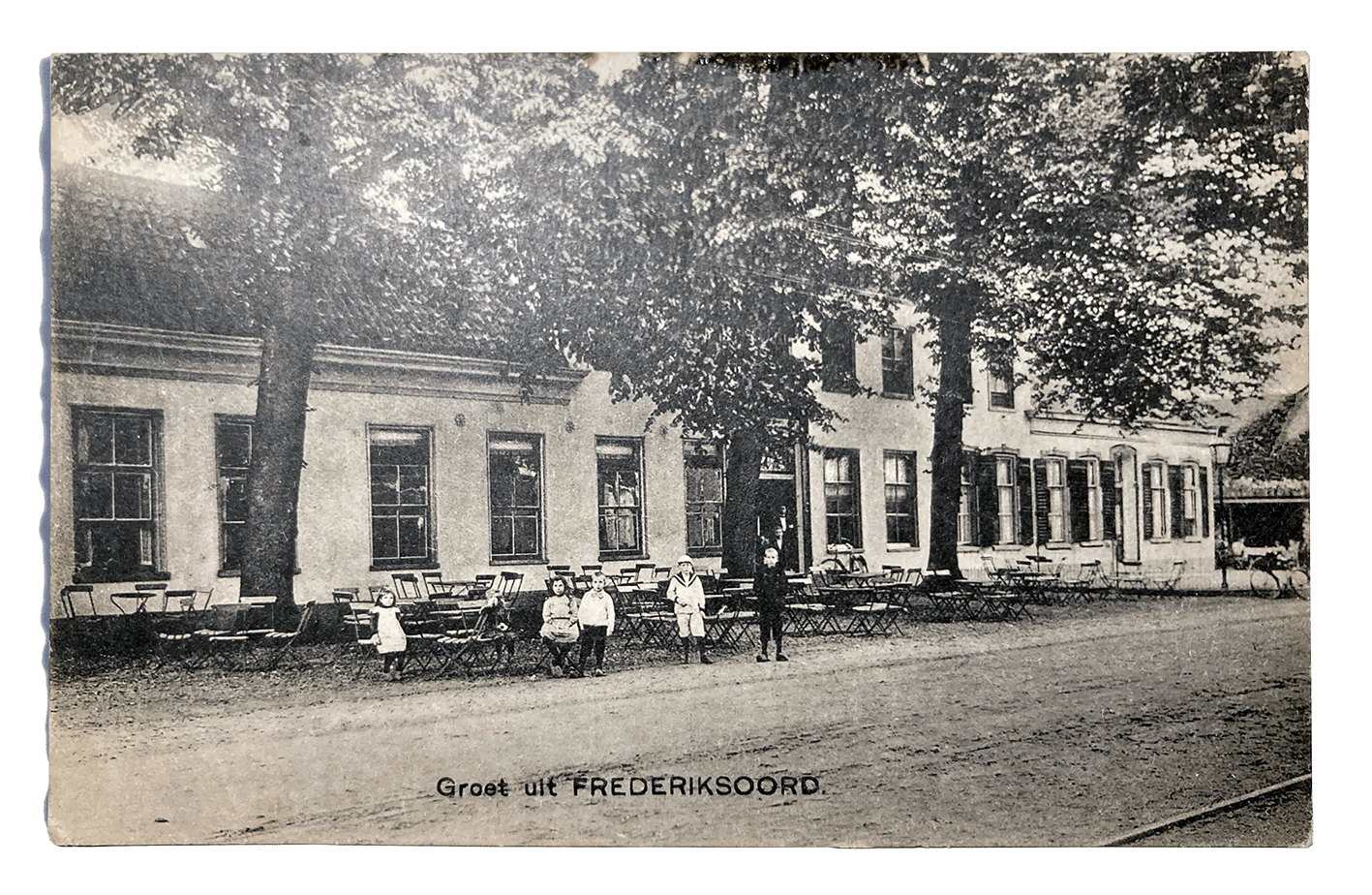Plot, Tree and Lane – Hanneke Stuit & Neeltje ten Westenend
Plotting Counter Visuality in Growing Archive of (Re)Construction
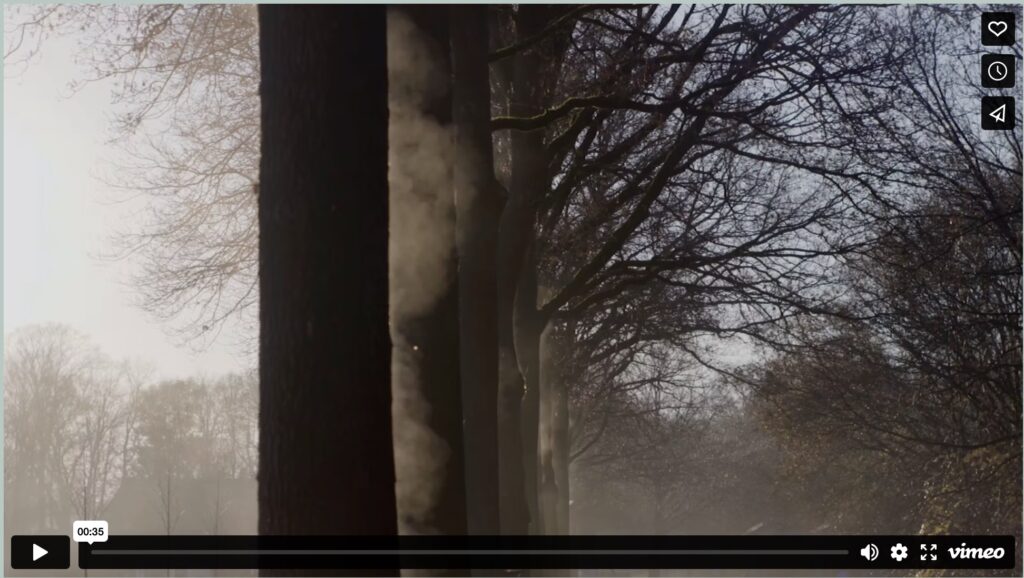
♦ Growing Archive 28/11/2021_video footage_morning mist / ♦ Growing Archive 30/10/2019_sound archive_church organ
A row of trees along a country lane with puffs of fog between the tree trunks. Is this a timelapse, or does fog really move this quickly? In the next image, a long shot of fog hovering over a plot of land, the fog is still. As if mist hangs over this place and obscures a proper understanding of it. When the footage cuts back to the row of trees and a truck enters the frame, however, the fog proves to be more dynamic and material than that. The sense of wonder returns. As the truck comes closer, the fog is pushed from in between the trees, then is sucked back in, registering the disturbance in the air. It is there before the truck arrives and it will be there after it is gone. This lane is not just for passing through, but rather invites viewers to contemplate the lane beyond a human-scaled sense of time and “purpose.”
The Colonies of Benevolence
The country lane is the Wilhelminalaan in Wilhelminaoord, located in the Colonies of Benevolence (Koloniën van Weldadigheid) in Drenthe, the Netherlands. Consisting of seven agricultural colonies built between 1818 and 1825 on domestic soil,1 the Colonies of Benevolence were initiated by colonial officer Johannes van den Bosch in 1818 to alleviate the destitution that befell the Netherlands after the Napoleonic Wars. On the one hand, the colonies were intended to help impoverished urban populations earn a living, to experiment with industrial and agricultural innovation, and, by doing so, to contribute to modernising the Dutch national economy through social engineering. On the other hand, political elites were also concerned with neutralising the revolutionary risk posed by the growing group of urban poor in Dutch cities at the time.2 This could be achieved, van den Bosch believed, by uplifting the poor through education, moral reform, and working the land.
The first of the Colonies of Benevolence to be realised was Frederiksoord, a utopic undertaking where families were to engage in subsistence farming on small farms of six to seven acres each (three morgen in Dutch).3 These families received basic facilities like education, health care, and care for the elderly in exchange for their labour. For this reason, the Colonies are often lauded as the point at which the Netherlands transitioned from localised charity to a semi-state-organised form of welfare.4 Indeed, the Colonies were remarkably progressive in this sense.5 Yet, establishing them also involved disrupting the semi-feudal marke system and dispossessing local farmers from communally used land.6 As Albert Schrauwers has made clear, these marken “owned ninety percent of Drente’s [sic] unused land, and were viewed as a conservative institution whose communal aspects hindered the adoption of modern, intensive agricultural methods.”7 The execution of van den Bosch’s plan thus radically transformed the fabric of the existing landscape and inscribed it with a moral approach to domestic utility that expressed itself in an indentured labour system.
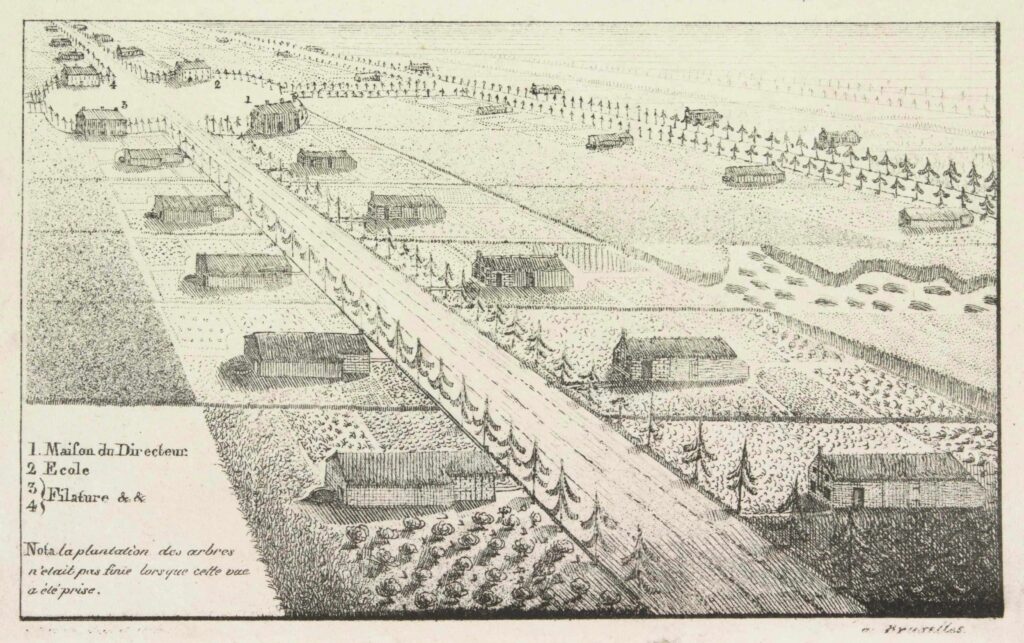
The small farm, its inventory, and the colonists’ clothes were provided on loan by the Society of Benevolence (Maatschappij van Weldadigheid).8 Colonists worked on communal farms and in collective workhouses during the week, and the harvests from the individual plots were used to alleviate the debts that colonists incurred with the Society of Benevolence for their upkeep.9 Each farm was inhabited by a family of two parents and their children, with the boys typically working the land and the girls the weaving mills. Retired colonists were expected to move out, and if one of the parents was widowed and did not find a new spouse or if a family did not have enough children to ensure the upkeep of the farm, they would be supplemented with single young adults or orphans selected by the Colonies’ management.10 Despite this semblance of a given family’s “individual tenure on a two-hectare parcel of land, the paupers who settled at Frederiksoord were part of a larger disciplinary order” characterised by military discipline and supervision.11 In this sense, Schrauwers has argued, the Colonies of Benevolence closely resemble “the plantation’s collective organization of coerced labour in planned communities.”12
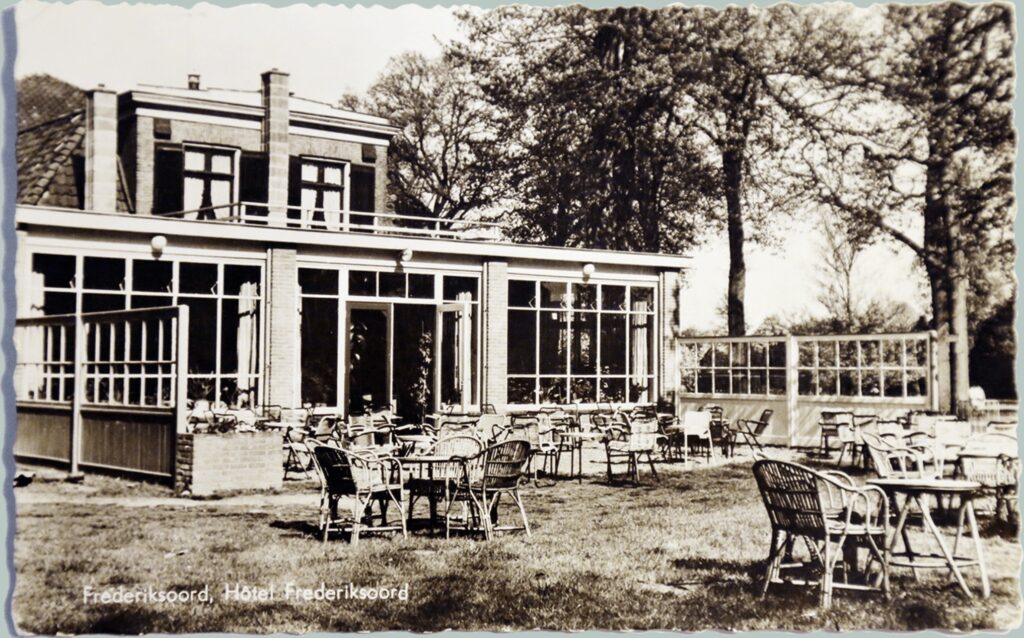
Plantation Connections
Defining the plantation in the Americas as a town—with its own economic systems,13 sets of laws and transportation networks that connected it to the wider world—professor of gender and Black studies Katherine McKittrick explains how the plantation model transformed supposedly empty unused landscapes into properties that could be owned. This transformation is “about replacing an ecosystem with an agrosystem” through the emptying out of the slave body.14 Ultimately, this system propelled a larger “economic structure that would underpin town and industry development in the Americas’ in general.”15
Similarly, the Colonies of Benevolence attempted—in a mixed spirit of charity, moral uplifting, and productivity—to turn land and people who would otherwise “lie fallow” into productive participants labouring to become modern. Van den Bosch’s ideas for the Colonies emerged from his experiences with his own plantation, Soedimara near Batavia, which he realised on several thousand morgen of wasteland in 1808. There, he drained the land and made large profits by putting the “idle” to work in “a closed administered community of coerced labourers ‘who formerly made bad use of their time’” and who needed to be taught how to labour.16 Subsequently, van den Bosch would bring his insights from the domestic case to bear on colonial policy in the Dutch Indies in the infamous “cultuur system” (cultivation system).17
Without conflating the cruelty of plantation life with the relatively benevolent case of Dutch colonization on domestic soil, they were nonetheless part of the same imperial system. The level of benevolence depended on whether one was “relegated to [the] colony or plantation by class in the Netherlands, or by race in Java.”18 Labourers in the Netherlands were ultimately expected to learn how to make a salary of their own in “normal” society, whereas the economic bondage of people on plantations on Java was so severe that they would never be able to leave. The two forms thus represent two sides of the same imperial coin, with domestic colonisation as the solar side and the plantation as the nocturnal one, as historian and political theorist Achille Mbembe would have it.19 Both groups were, however, in essence deemed unworthy of liberal rights and, therefore, deserving of plantation life.
What insights emerge if we see Dutch domestic colonies as part of a larger plantation complex—as an “imbrication of mentality and organization [that] produces a visualized deployment of bodies and a training of minds, organized so as to sustain both physical segregation between rulers and ruled, and mental compliance with those arrangements”?20 In this publication, we discuss artist, filmmaker, and educator Neeltje ten Westenend’s Growing Archive of (Re)Construction (2018–ongoing; hereafter, Growing Archive), from which the footage and images that carry this publication are taken, to further investigate the relation between the Dutch domestic colonies and the plantation model. We focus particularly on how ten Westenend questions the powers of framing and staging associated with plantation models and foreground the results of her artistic research as a deepening of Sylvia Wynter’s famous notion of the plot.21
Growing Archive of (Re)Construction
The Colonies of Benevolence’s infrastructure and design are still clearly visible in the landscape, now a protected UNESCO site with several museums. When one visits the Colonies, it is clear that the sites tend to cater to a touristic, spectacularising, and mostly external gaze. This is especially true for the penal colony of Veenhuizen, where the National Prison Museum houses a gift shop that exoticises criminality and idealises the Colonies’ rural location.22 Whereas the penal colony of Veenhuizen is increasingly well-known, the so-called “free” colonies, where colonists lived in a system of control on their small farms but were not incarcerated in the strict sense of the word, are not widely discussed. When they are, the approach tends to be idyllic; historical realities of indentured labour and confining forms of sociality involved are played down and the perspectives of local inhabitants today tend to be subsumed by this touristic gaze.23
Between 2018 and 2021, ten Westenend lived in one of the small farms in Wilhelminaoord, known in this region as a koloniewoning (colony home). During this time, she had many conversations with local residents and professionals involved in the area. Her artistic research methods of participant observation and visual research feed into the Growing Archive project. This digital mixed-media archive consists of audio- and video materials directed by ten Westenend herself, as well as existing postcards, photographs, and textual documentation. From this archive, ten Westenend builds reconstructions that rework dominant narratives circulating about the Colonies to this day and that seek to unravel the Colonies’ machine of looking. As the title suggests, the project is still in progress and is designed to remain open-ended. This open-endedness reflects ten Westenend’s ambition to offer room for alternative, bottom-up narratives and perspectives.
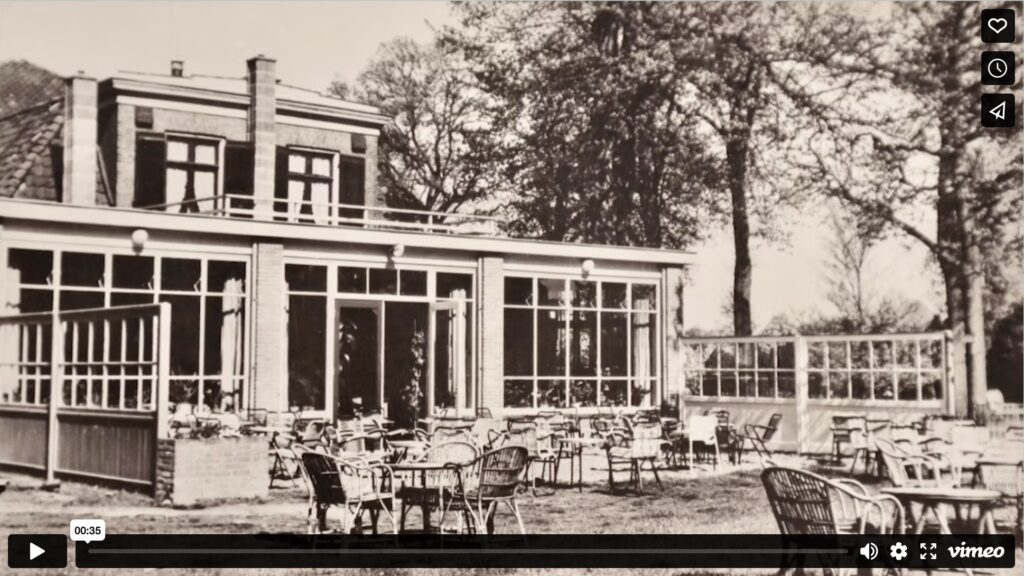
♦ Growing Archive 12/08/2022_postcard studies_hotel fragments
As ten Westenend’s reworking of these postcards suggests, such an external gaze was part of the Colonies’ design from the very start. Construction of the colonies started in Frederiksoord, because that town already had a logement (hotel) where the Colonies’ creators and other curious visitors could spend the night.24 The very existence of these postcards indicates that being seen is and always has been fundamental to the funds needed to maintain the Colonies.25 In order to raise these funds, the Colonies had to be regarded, not only as successful, but also as beautiful. In the case of the postcards rendered here, ten Westenend foregrounds a quiet haunting that picks at the construction of this external, pleasing visuality; the hotel and garden are meant to house guests, but the garden chairs are empty.
Plot and Plantation
If the Colonies of Benevolence were part of a more expansive plantation complex involving indentured labour and disciplinary population management, the small farms in Wilhelmina- and Frederiksoord could be considered as that complex’s plots, to speak with Wynter.
Plots were little patches of ground on or around the plantation that were worked by enslaved people in their spare time for subsistence farming. Although intended to optimise plantations in terms of efficiency and profit by having enslaved people feed themselves, these plots are also the basis of a social order that negates the logic of the plantation. The plot nurtured the emergence of localised folk cultures that formed a “source of cultural guerilla [sic] resistance against the plantation.”26 Although lodged within the plantation itself, the plot is thus also “a point outside the system [that] can give us a focus of criticism” on it.27
Wynter emphasises the cultural importance of the plot and ties this cultural value to the need to maintain connections to the land. In the plantation system, the balance in which “Man adapts to Nature, and adapts Nature to his own needs” is broken in favour of the “reduction of Man to Labour and of Nature to Land.”28 On the plot, at least, “the land remained the Earth,” Wynter seems to claim wistfully, but she makes sure not to romanticise the plot: “[T]here is no question in going back to a society, a folk pattern whose structure has already been undermined by the pervasive market economy.”29 In other words, thinking through the plot is not a naïve return to a pristine past unmarked by market logic, but rather an injunction to think through the damage that this logic has done. Plotting is a tool for going forward with equity.
In what follows, we will pay attention to these issues but focus most of all on how Growing Archive furthers Patricia de Vries’s invitation to “explore the plot not just as a historical event, a production system, or a model for current city arrangements, but also as a form of artistic research.”30 What becomes visible when we use plotting to look more closely at the Colonies of Benevolence as they present themselves to us today?
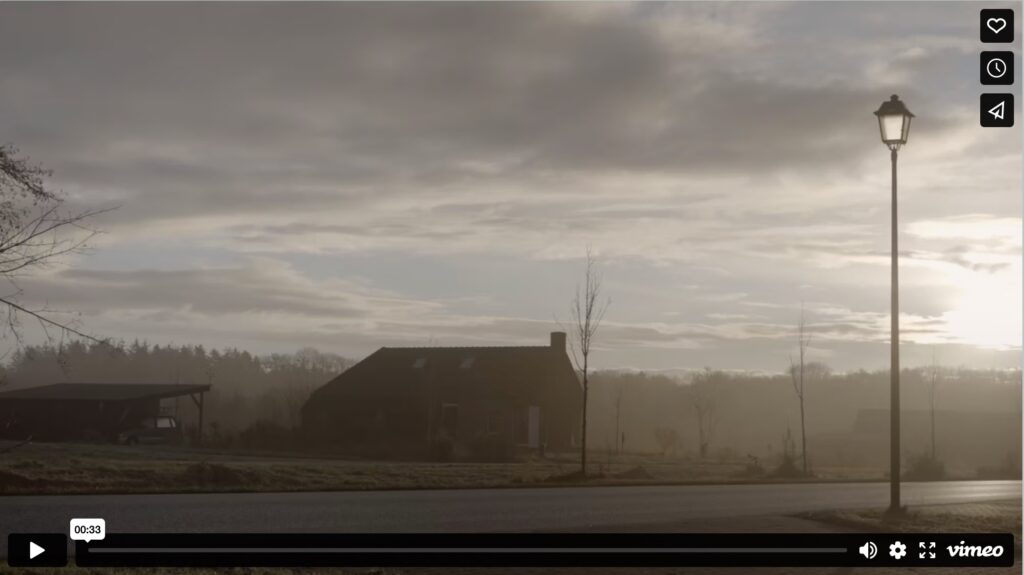
♦ Growing Archive 28/11/2021_video footage_morning mist / ♦ Growing Archive 30/10/2019_sound archive_church organ
We see a new colony house from just far enough for detail to fall away. It becomes part of the landscape and the weather on the morning the footage is shot. This stillness and lack of spectacle raises questions about what looking at and from the Colonies’ plots actually entails. Who is looking at what exactly, and what are the distributions and assumptions about power related to that looking?
Turning the Outside Gaze Inside Out
Significant parts of ten Westenend’s project revolve around the different perspectives on and from the plot of the koloniewoningen, all of which are privately used and inhabited. Whether the houses are renovated or built from scratch, we are dealing with reconstructions in both cases: above, we see the about-to-be renovated interior of the koloniewoning where ten Westenend lived, but sometimes we see one of the newly constructed versions, which were added to the landscape in recent years to emphasise the area’s original landscape design.31
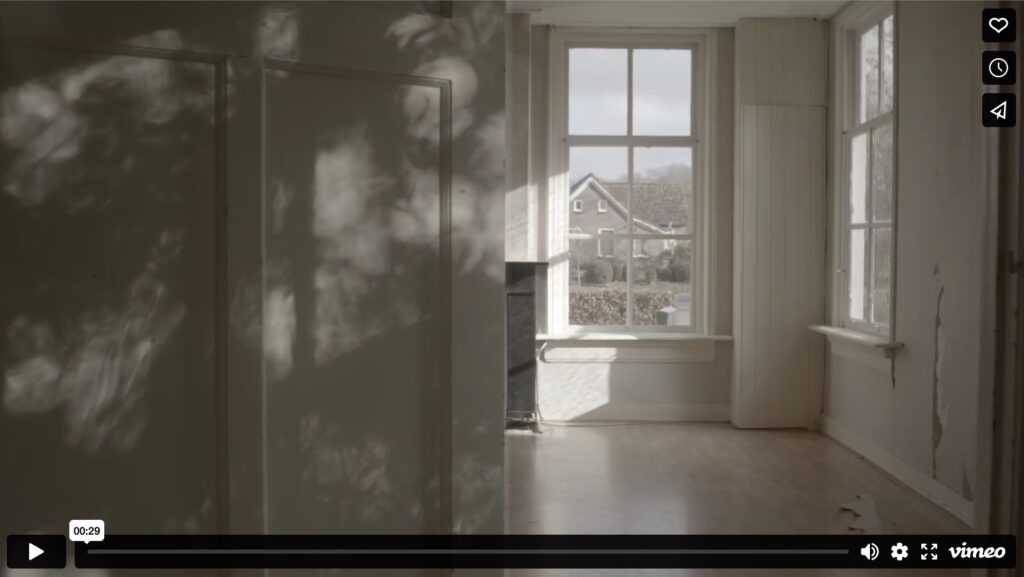
♦ Growing Archive 07/02/2022_video footage_interior looking out / ♦ Growing Archive 30/10/2019_sound archive_church organ
As visual culture theorist Nicholas Mirzoeff argues in The Right to Look (2011), looking can be an act of claiming political subjectivity when faced with dominant forms of visuality. Such hegemonic visuality consists of three operations: it classifies by naming, categorising, and defining; it then separates the resultant groups from each other as a means of social organisation; and finally, makes this classification and separation seem right and aesthetically pleasing.32 The slave plantations in the United States were one of the first domains in modernity where such divisive but “aesthetically pleasing” hegemonic visuality was “perfected.”33 In the case of the Colonies of Benevolence, the idealisation of the rural setting provides precisely such an aesthetically pleasing front for its underlying disciplinary machinations.
Visuality, in this sense, seeks “to maintain the ‘colonial environment’ as it was” whereas the act of looking describes the attempt to offer a counter visuality that represents “a different reality, modern but decolonized.”34 What Mirzoeff calls the right to look can thus be meaningfully aligned with Wynter’s description of the plot and the plantation. In this equation, dominant discourses and visual complexes stand for the plantation, and counter visuality—the political right to look at dominant visuality askew, so to speak—becomes a form of plotting.
(Re)Plotting What is Visible
Growing Archive facilitates a counter visuality through its methods of active plotting, that is, through its creation of new ways of looking at and from the plot that intervenes in the otherwise automated and naturalised feedback loop between the onlooker and what is being looked at. In doing so, it performs acts of looking that are not motivated by profit or exoticism (a gawking at) but that make space for alternative stories and life worlds that turn the Colonies’ reliance on the outside gaze inside out.
Growing Archive, a project designed to remain in progress, will consistof several distinct but thematically related artworks that achieve this plotting in different ways. One of these works is a film of postcard fragments that reworks daily scenes from the various Colonies between 1890 and 1965.
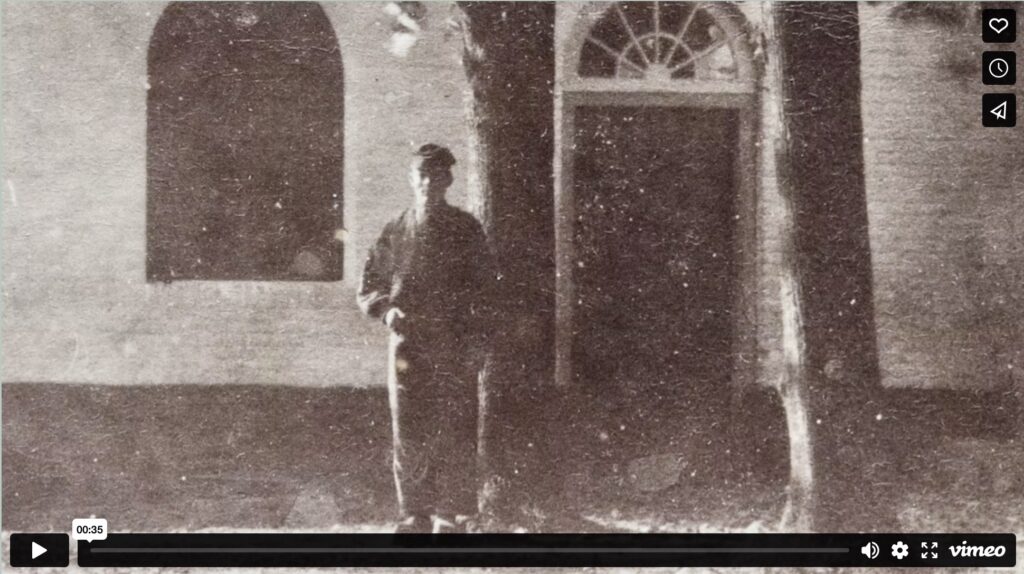
♦ Growing Archive 15/10/2022_postcard studies_posing fragments
Ten Westenend alienates viewers from the picturesque expectations of the genre of the postcard by zooming in on them, selecting unexpected details, and adding new forms of lighting. Rather than simply “flattening” the materiality of the postcards into digital files, ten Westenend’s process re-archives them as lively material objects with their own “grain”— “something is there, manifest and stubborn” in the prolonged posing needed during the lengthy exposure times of nineteenth-century cameras.35
A second work investigates how Museum De Proefkolonie in Frederiksoord seeks to make colony houses accessible to visiting audiences. In this short film, ten Westenend pays attention to the intensified techniques of framing that go into unlocking life in the Colony for the public.
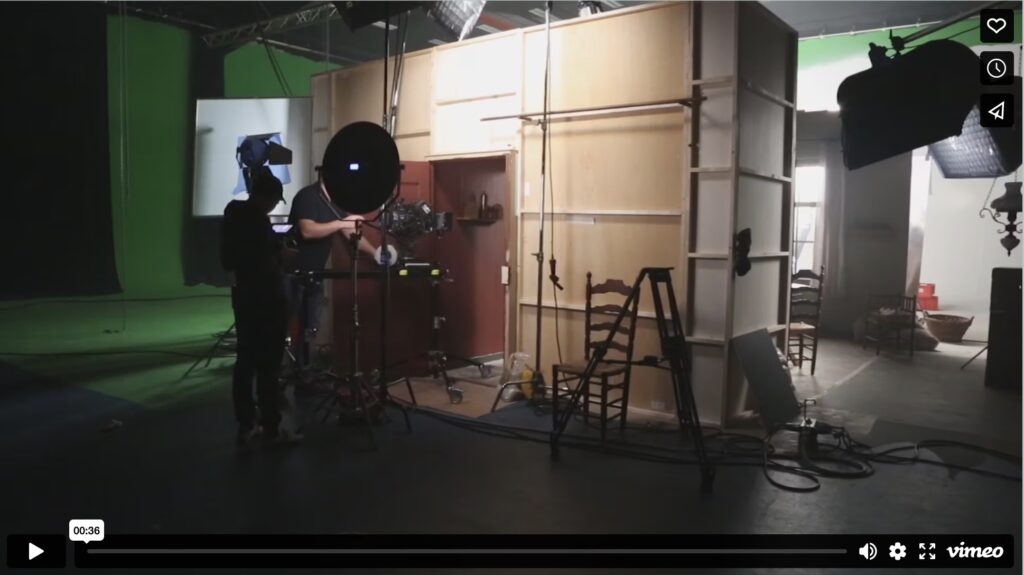
♦ Growing Archive 27/01/2019_film set_domestic scenes / ♦ Growing Archive 30/10/2019_sound archive_church organ
An important aesthetic strategy is the use of mise en abyme. Ten Westenend offers footage of the film set of the educational film currently on display in Museum De Proefkolonie. The footage zooms out of a domestic scene with actors in colony clothing. This scene is filmed in the interior of a colony house built for this purpose in the studio, which, in turn, reproduces the only colony house in Frederiksoord that is open to the public. That latter replica was built by the museum in the 1990s and its dimensions are slightly more spacious than the original dwellings, so that several visitors can take a peek at the same time. In ten Westenend’s footage, the replica of the colony house’s replica is surrounded by cinematic professionals and equipment and the camera moves in like a drill, poking into what we imagine the Colonies’ past to have looked like.
In these ways, Growing Archive contributes to the increasing number of perspectives coming to light about what life in the Colonies was like for the colonists themselves.36 But Growing Archive also differs from these existing perspectives—whether of an educational, touristic, or historical nature—because it questions how audiences normally encounter the Colonies. Through zooming in and zooming out, Growing Archive investigates the notion of perspective itself and takes concrete steps in plotting against, or rather replots, how the Colonies of Benevolence are usually seen and looked at.
The Just-Below-the-Canopy Perspective
The camera is aimed at waterlogged soil containing rows of the decaying remnants of neatly planted, now harvested crops. The perspective is elevated, rising slowly, and levelling out to bring a copse of trees beyond the field into view. As the camera moves to the right, we cross a property boundary, and a garden appears. In the garden, we see one of the few remaining original koloniewoningen.
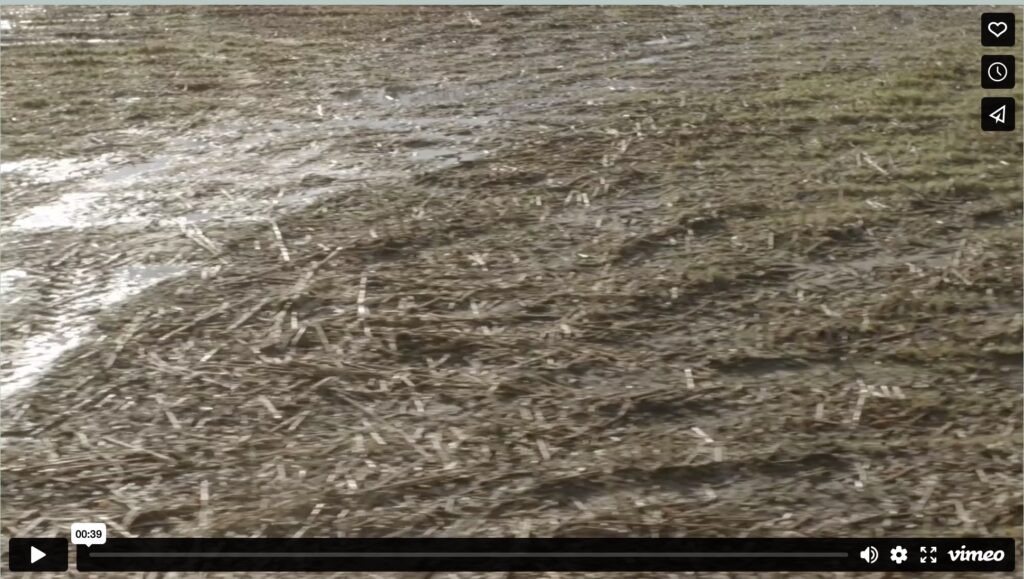
♦ Growing Archive 29/11/2021_video footage_plateau perspectives / ♦ Growing Archive 30/10/2019_sound archive_church organ
Passing these small farms on foot, by bike, or by car, one is constantly tempted to look in on the lovely gardens and the small, idyllic houses. This temptation ties in with the fact that the perpendicular lanes aided surveillance of the colonists. These days, however, one could never gain an unobstructed view like the one offered by ten Westenend; hedges frustrate a voyeuristic desire to look in at eye level.
Yet, the perspective is not entirely aerial. It is not strictly speaking a gaze from above, which has become increasingly familiar through the use of drones and which is prefigured in the etching showing the original plans for Frederiksoord.37 Facilitated by a plateau attached to a tractor that slowly drives down the lane, the perspective offered in Growing Archive is positioned just below the point where the canopy of the trees starts, a view that completely changes the feel of looking. The trees glide by one by one, temporarily obstructing the view, but overall, the eye is liberated from the limitations of viewing the scene at human eye level.
What we are experiencing is a medium-level view that foregrounds the entanglement of humans and more than human entities that makes this perspective possible in the first place: human, machine, house, tree, soil, and landscape. Ten Westenend adds a crucial perspective to our aesthetic arsenal and, thus, to our imagination: the just-below-the-canopy perspective, which mediates between the limits of human eye levels and the surveillance and mastery associated with views from above.
Today’s Plot
The first plateau experiment moves from left to right and brings into view a close-to-original koloniewoning. If we imagine the passage of time as a line running from left to right (as is customary but inaccurate in Western conceptions of time we can imagine this historical building being “projected” into the future. The second platform experiment shown directly above, however, moves from right to left while depicting a newly built house, thus projecting a modern view on the historical plots “back” into time.
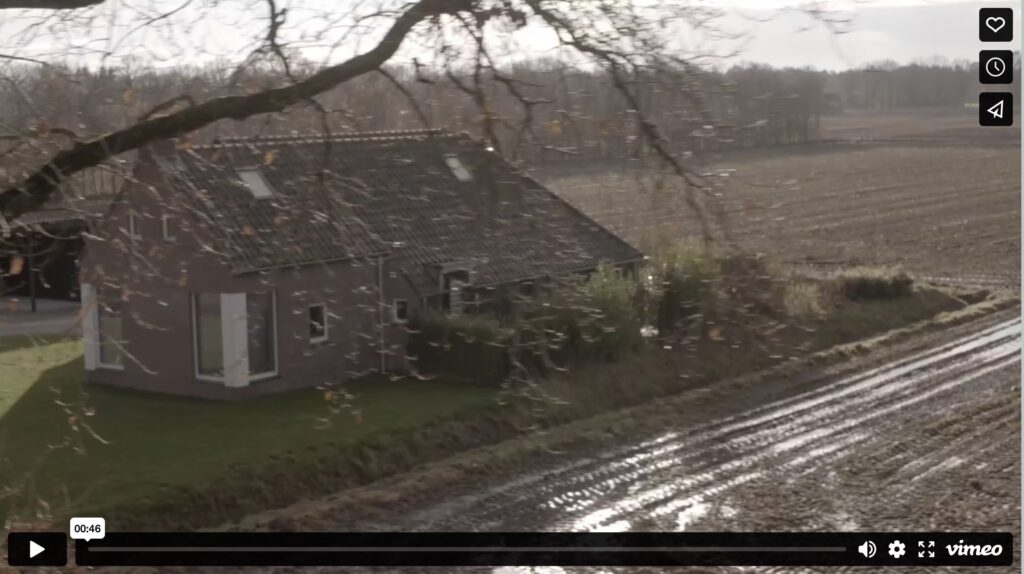
♦ Growing Archive 29/11/2021_video footage_plateau perspectives / ♦ Growing Archive 30/10/2019_sound archive_church organ
By showing the new house as under construction, the footage further highlights the connection of the plots across time through the rural idyll, the desire to own a plot of one’s own, to one day fulfil the dream of owning property surrounded by green fields.38 In the original setup of the Colonies of Benevolence, of course, the small farms could never be owned. The rural idyll of the Society of Benevolence was “thin” in this respect and only served as a catalyst for moulding individuals who could create a surplus for the national market. In the present day, the cottage aesthetic of the farms makes for compelling modernised architecture in a landscape that bears the traces of this ambiguous political economy. Due to the region’s UNESCO status and the practical demands of preserving such a unique landscape, the land continues to be leased out to the owners of the new farms. To preserve this crucial part of Dutch history, then, the idyll of the small farm continues to feed the mills of the quiet gentrification of the countryside.
Trees Telling Time
The just-below-the-canopy perspective quietly disrupts the Colonies’ dominant schemas of visuality. Firstly, because it mediates between human and machine and secondly, because it foregrounds the persistence of the rural idyll in the Colonies’ presentation through time. A third important aspect of the just-below-the-canopy perspective is that it proceeds to puncture these idyllic layers in the landscape by drawing in the tall trees with which this text opened, planted along the roads as part of the original design, the trees are an important part of the engineered landscape. and reflect the Colonies’ simultaneously militaristic and benevolent intentions. On the one hand, the tree-lined lanes echo Napoleon’s desire to provide shaded roads for marching armies. On the other, their dreamy lushness was explicitly intended to improve the quality of life in the Colonies and belies any disciplinary purpose.39 Indeed, the tree-filtered light in the late afternoon is exquisite. The smell of the place in the early morning is a delight.
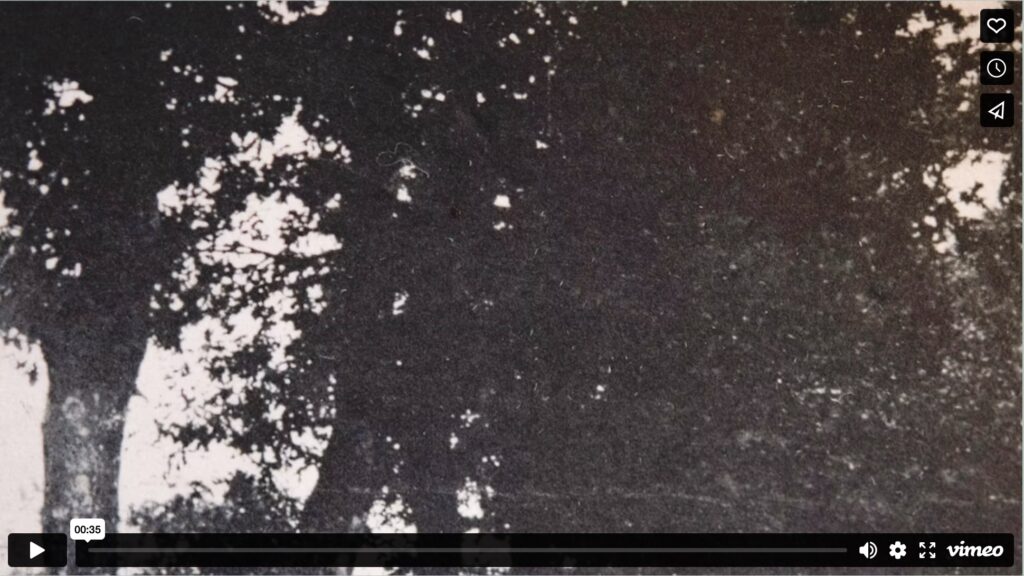
♦ Growing Archive 18/11/2022_postcard studies_tree time fragments
The trees overlay the scenes of the plot with rhythm and scale the human activities on the plot across almost two centuries. Trees are essential indications of the passage of time. Their foliage gives us an indication of the seasons. Their size indicates that they were there before any of us cycled or walked through the lanes. They are still there now as linear forests with great ecological value because they house many birds, bats, and invertebrates.40 Besides this, some of the trees also have great cultural value because they were planted in the Colonies’ earliest years and show ways of pruning that are no longer current. If we were to cut them down, they could tell time as reliably as any archive could, but we lose a whole network of cultural and ecological roots. Even if engineered by people, it is not, in the end, the human that scales an understanding of these landscapes. It is the other way around: the trees are entangled with and indicate the passing and the relativity of human time.
The Gleaming Soil
The explicit role of the trees in the just-below-the-canopy perspective is also tied to the future. Because of the not-quite-human- yet not-quite-aerial view, we see the sun gleaming on the puddles in the waterlogged soil. The gleaming does not render the landscape picturesque, however. The rhythm of the trees along the lane and the tilted perspective disrupt that genre’s reliance on the unencumbered view of a fore, middle, and background. Instead, we see the soil in sharp relief, evoking worry about the effects of climate change on the soil itself, without which no life is possible. This gleaming soil thus returns us to Wynter’s emphasis on plotting as maintaining connections to the earth, even within the violent system of plantation logics.
In line with Wynter, Growing Archive crucially avoids a romanticisation of the Colonies’ spaces. In deconstructing the act of looking through mise en abyme, in showing the grain in the colonists’ poses in the postcards, in offering a more than human perspective on the plot, Growing Archive questions the Colonies’ ongoing reconstruction and tries to add to it with equity. Disrupting the aesthetic of spectacle, ten Westenend’s Growing Archive of (Re)construction offers quietly plotting scenes that activate acts of looking beyond the sites’ function as monuments to the Colonies’ past—important as such monumentality is. As the idyllic renderings of a coercive past, the small farms in the Colonies of Benevolence are critical sites from which to develop different plots in which the Colonies can assume their place in a wider Dutch plantation history. Ultimately, this plotting makes room for contemplating rather than staging the entanglement of human histories with the landscape itself.
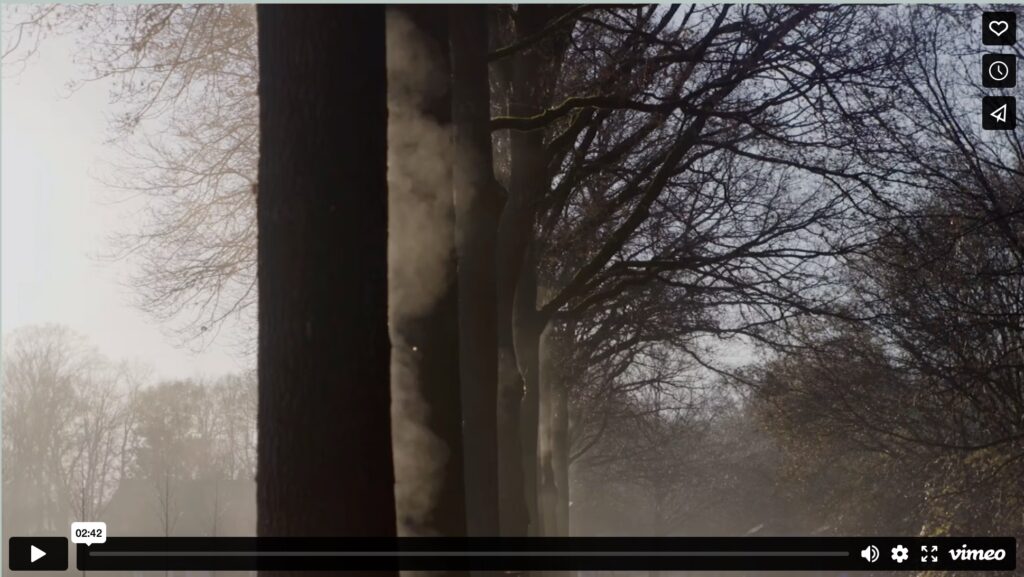
♦ Growing Archive 28/11/2021_video footage_morning mist / ♦ Growing Archive 30/10/2019_sound archive_church organ
Credits: Video footage in cooperation with cinematographer Benito Strangio. Church organ sounds by Harry de Wit. The text is based on conversations between Neeltje en Hanneke and eventually penned by Hanneke.
Hanneke Stuit is associate professor of literary and cultural analysis at University of Amsterdam, and affiliated to Amsterdam School of Cultural Analysis (ASCA). She works on cultural imaginations of the prison and on the intersections between carcerality and the rural in South Africa and the Netherlands. She is the author of Reimagining the Rural: Pastoral Entrapment and Dis-enclosure in South Africa (forthcoming). Previously, she edited the special issue Dutch Domestic Colonisation: From Rural Idyll to Prison Museum (2020), and recently co-edited the volumes Planetary Hinterlands: Extraction, Abandonment and Care (2023) and Carceral Worlds: Legacies, Textures and Futures (2024).
Neeltje ten Westenend is a Dutch artist, researcher, filmmaker and lecturer. She studied at Design Academy Eindhoven (Man & Public Space, 2003, with honors) and obtained an MA from Sandberg Instituut, Amsterdam (Studio for Immediate Spaces, 2017). In context-specific projects ten Westenend investigates the representation and perception of places and ways in which meaning is attached to them. Research processes take shape in cartographic works, choreographic and spatial interventions, reconstructions, (music) compositions, as well as short films and publications. Projects include Perfect Day (2008), Contour (2013), Tractordans (2014), and Growing Archive of (Re)construction (2018–ongoing). The latter consists of artistic research into representations of the history of the Colonies of Benevolence in the Dutch province of Drenthe. Through this project she has been affiliated with LASP (Research Group Art & Spatial Praxis) since 2020. Ten Westenend lectures at Design Academy Eindhoven where, among other things, she developed the educational program Mapping the City, an introduction to cartography and participatory field research. She also teaches at the master in interior architecture at the Royal Academy of Art, KABK, The Hague.
- In the Netherlands: Frederiksoord (1818), De Ommerschans (1819), Wilhelminaoord (1820-1822), Willemsoord (1820-1823), and Veenhuizen (1823). Later, Colonies were erected in the Southern Netherlands, now Belgium, following the same model: Wortel in 1822 and Merksplas in 1825. ↩︎
- Angelie Sens, De kolonieman: Johannes van den Bosch (1780-1844) – Volksverheffer in de naam van de koning (Amsterdam: Balans, 2019), 350. ↩︎
- Johannes van den Bosch, Verhandeling over de mogelijkheid, de beste wijze van invoering, en de belangrijke voordeelen eender algemeene armen-inrigting in het Rijk der Nederlanden, door het vestigen eener Landbouwende Kolonie in deszelfs Noordelijk gedeelte (Amsterdam: Johannes van der Heij, 1818), 146, https://www.dbnl.org/tekst/bosc036verh01_01/index.php. ↩︎
- Sens, De kolonieman, 175. ↩︎
- The Colonies of Benevolence: An Exceptional Experiment, Kathleen De Clercq, Marja Van den Broek, Marcel-Armand Van Nieuwpoort, and Fleur Albers, eds. (Assen: Royal Van Gorcum Publishers, 2018), 121. The freedom of religion is still clearly reflected in Veenhuizen, where a catholic church, a protestant one, and a synagogue are lined up along one of its central thoroughfares. ↩︎
- In the marke system, free owners of farmsteads also had use rights in the communal farmlands of the village (called the es). People who did not own land could not work the es, but the community—landowners as well as the so-called keuters—had use rights of the uncultivated land, like woodland and pasture, surrounding the es. See Albert Schrauwers, “The ‘Benevolent’ Colonies of Johannes van den Bosch: Continuities in the Administration of Poverty in the Netherlands and Indonesia,” Comparative Studies in Society and History 43, no. 2 (April 2001), 308–309. Also see Sens, De kolonieman, 173. ↩︎
- Schrauwers, “The ‘Benevolent’ Colonies,” 309. ↩︎
- The Society of Benevolence was the foundation that ran and financed the Colonies. Some parts of the Society’s finances were provided by the Kingdom of the Netherlands and others by charitable members from urban elites in the form of periodical contributions. These types of corporations were delegations of state authority that allowed investors to make “profits on public resources in the provision of public services”—a structure that closely resembled the corporate structure of the VOC. For more information, see Albert Schrauwers, “Colonies of Benevolence: A Carceral Archipelago of Empire in the Netherlands,” History and Anthropology 31, no. 3 (2020), 352, footnote 2. ↩︎
- Wil Schackmann, De strafkolonie. Verzedelijken en Beschaven in de Koloniën van Weldadigheid, 1818-1859 (Amsterdam: Atlas Contact, 2018), 14. ↩︎
- Schackmann, De strafkolonie, 74. ↩︎
- Schrauwers, “The ‘Benevolent’ Colonies,” 309. ↩︎
- Schrauwers, “Colonies of Benevolence,” 359. ↩︎
- The Colonies had their own currency and commissary system. See Wiebe Nijlunsing, Het huisgeld en de penningen van de Maatschappij van Weldadigheid en de Rijksgestichten 1821-1871 (Assen: Uitgeverij Van Gorcum, 2022). ↩︎
- Achille Mbembe, Necropolitics (Durham, NC: Duke University Press, 2019), 10. ↩︎
- Katherine McKittrick, “Plantation Futures,” Small Axe 17, no. 3 (2013), 8. ↩︎
- Van den Bosch quoted in Schrauwers, “Colonies of Benevolence,” 359. ↩︎
- For more on these connections, see Schrauwers, “The ‘Benevolent’ Colonies” and Sens, De kolonieman. See also Schrauwers, “Colonies of Benevolence,” 352–370; and Anke Bosma and Tjalling Valdés Olmos, “The Coloniality of Benevolence,” Collateral 23 (2020), https://www.collateral-journal.com/index.php?cluster=23. ↩︎
- Schrauwers, “Colonies of Benevolence,” 366. ↩︎
- Mbembe, Necropolitics, 22. ↩︎
- Nicholas Mirzoeff, The Right to Look: A Counterhistory of Visuality (Durham, NC: Duke University Press, 2011), 5. ↩︎
- The archival material that ten Westenend works with can be found in Drents Archief, Assen. ↩︎
- Esther Peeren, “Enter through the Gift Shop: The Rural Pauper Colony of Veenhuizen as a Tourist Attraction,” Collateral 23 (2020), http://collateral-journal.com/index.php?cluster=23. ↩︎
- Hanneke Stuit, “The Carceral Idyll: Rural Retreats and Dreams of Order in the Colonies of Benevolence,” Collateral 23 (2020), http://collateral-journal.com/index.php?cluster=23. ↩︎
- Wendy Schutte, private conversation, 8 May 2023. ↩︎
- The Society of Benevolence ran no less than three different journals to telegraph its successes to a wider public, see Sens, De kolonieman, 189–193. At the time of writing, the Colonies are represented on Google Culture and advertisements regularly appear on NPO Klassiek radio. ↩︎
- Sylvia Wynter, “Novel and History, Plot and Plantation,” Savacou 5 (1971), 95–102. ↩︎
- Ibid., 100. ↩︎
- Ibid., 99. ↩︎
- Ibid., 100. ↩︎
- Patricia de Vries, “Plot as an Artistic Praxis in Today’s Cityscapes,” Lectorate Art & Spatial Praxis (n.d.), https://networkcultures.org/wp-content/uploads/2023/09/Plot-Work_INC2023_Miscellanea.pdf. Crucially, Wynter’s attention to plot and plantation automatically implies the importance of rural perspectives, rather than fixating on the relevance of the urban space that the rural is presumed to “feed.” ↩︎
- These houses were built in the 2010s for the regular real estate market. They are replicas in the sense that they restore the structure of the original landscape design. They are, at the same time, not replicas in the strict sense of the word because their appearance has been modernised and they function as regular dwellings. ↩︎
- Mirzoeff, The Right to Look, 3. ↩︎
- Ibid., 2. ↩︎
- Ibid., 14. ↩︎
- Roland Barthes, “The Grain of the Voice,” in Image Music Text, ed. and trans. Stephen Heath (London: Fontana Press, 1977), 179–189. ↩︎
- Most famously, Suzanna Jansen’s Het pauperparadijs (2008) traces the material and emotional repercussions of her family’s ties with Veenhuizen. Wil Schackmann has published four volumes on the Colonies that tend to prioritise the perspective of the colonists in archival sources and Angelie Sens’s chapter on the Colonies in her biography of Johannes van den Bosch ties an overview of texts by colonists themselves to critiques from the time of the Colonies’ inception. These sources have proved crucial in unearthing the perspectives of the colonists themselves, some of whom managed to settle quite well and climb the ladder of the Colonies’ social hierarchy until they were released back into society. Others, however, never managed to settle in and continued to struggle with the moral order of the Colonies’ disciplinary system, leading to resistance and protest. ↩︎
- As “the signature technology” of contemporary warfare, drone perspectives offer an intensification of the traditional bird’s eye view that is as spectacularising as it is disconcerting in its invocation of disembodied surveillance and optimal efficiency. See Mirzoeff, The Right to Look, 20. ↩︎
- The brochure for the new colony houses reads “ . . . met erfpacht bent u verzekerd van een prachtige woonomgeving” (“. . . leasing ensures living in gorgeous surroundings”). ↩︎
- Bert Maes, De betekenis en ouderdom van de beplanting in de Koloniën van Weldadigheid. Cultuurhistorische en ecologische waardestelling van bomen en heesters in de Koloniën van Nederland en België, Ecologisch Advies Bureau Maes (2016). ↩︎
- Ibid. ↩︎
- Break Down, Or: Dismantling the House that Narrative Built – Moosje Moti Goosen
- notes towards an otherwise – gervaise alexis savvias
- A Young Cowboy First Saw the Lights: Part 1 – Philip Coyne
- Open Glossary for Queer (immaterial) Architectures – die Blaue Distanz
- BLACK HOLES MATTER! – Yangamini
- Queer and Anti-Colonial Gardening: A Syllabus – M. Ty
- Plot(ting): Practices of Ambiguity — Patricia de Vries
- Cartas de Agua – Francisca Khamis & Maia Gattás
- “Raised on Foundations of Slime” – Amelia Groom
- For a Possibility of Care, Not Ownership – Mariana Balvanera

